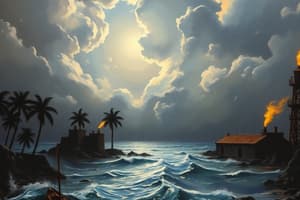Podcast
Questions and Answers
What is the minimum wind speed required for a storm to be classified as a hurricane?
What is the minimum wind speed required for a storm to be classified as a hurricane?
- 150 kmph
- 119 kmph (correct)
- 180 kmph
- 100 kmph
What is the primary source of energy for hurricanes?
What is the primary source of energy for hurricanes?
- Warm ocean waters (correct)
- Cloud formations
- Ocean currents
- Atmospheric pressure
What is the term for the low-pressure area formed when warm, moist air rises from the ocean surface?
What is the term for the low-pressure area formed when warm, moist air rises from the ocean surface?
- Tropical depression
- Eye of the storm
- Not mentioned in the content
- Low-pressure zone (correct)
How many categories are used to classify hurricanes based on their sustained wind speeds?
How many categories are used to classify hurricanes based on their sustained wind speeds?
What is the term for storms with wind speeds of 119 kmph or higher?
What is the term for storms with wind speeds of 119 kmph or higher?
What is the minimum wind speed required for a hurricane to be classified as a Category 5?
What is the minimum wind speed required for a hurricane to be classified as a Category 5?
How long did it take for Beryl to transform from a tropical depression to a Category 4 hurricane?
How long did it take for Beryl to transform from a tropical depression to a Category 4 hurricane?
What is the term for hurricanes with wind speeds of Category 3 and higher?
What is the term for hurricanes with wind speeds of Category 3 and higher?
What is the primary reason for the increase in frequency and scale of Arctic wildfires in recent years?
What is the primary reason for the increase in frequency and scale of Arctic wildfires in recent years?
What is the main consequence of the increased frequency and scale of Arctic wildfires?
What is the main consequence of the increased frequency and scale of Arctic wildfires?
What is the main source of ignition for Arctic wildfires, according to the content?
What is the main source of ignition for Arctic wildfires, according to the content?
What is the average temperature increase in the Arctic region compared to the pre-industrial level?
What is the average temperature increase in the Arctic region compared to the pre-industrial level?
What was the total carbon emissions from Arctic wildfires in June, according to the Copernicus Climate Change Service?
What was the total carbon emissions from Arctic wildfires in June, according to the Copernicus Climate Change Service?
Why is it more likely to have thunderstorms over ice-free land than land covered with ice?
Why is it more likely to have thunderstorms over ice-free land than land covered with ice?
What is the primary concern with regards to Arctic wildfires and climate change?
What is the primary concern with regards to Arctic wildfires and climate change?
What is the consequence of the polar jet stream getting stuck in one place?
What is the consequence of the polar jet stream getting stuck in one place?
What is the estimated amount of carbon stored in Arctic permafrost?
What is the estimated amount of carbon stored in Arctic permafrost?
What is the consequence of wildfires on permafrost?
What is the consequence of wildfires on permafrost?
Study Notes
How Climate Change Fuels Hurricanes
- Hurricane Beryl broke records as the earliest storm to reach Category 5 classification during the Atlantic hurricane season.
- The storm caused at least 11 deaths and triggered intense floods and dangerous winds in Jamaica, Grenada, Saint Vincent and the Grenadines, and northern Venezuela.
- Hurricane Beryl made landfall in Texas, United States, as a Category 1 storm, flooding streets and leaving over two million people without power.
How Hurricanes Are Formed
- Hurricanes, or tropical storms, form over warm ocean waters near the equator.
- Warm, moist air from the ocean surface rises, creating a low-pressure area below.
- Air from surrounding areas with higher air pressure rushes into the low-pressure area, rising and becoming warm and moist.
- As warm, moist air rises, it cools down, forming clouds and thunderstorms.
- The system gains strength and momentum using the ocean's heat and evaporating water.
Hurricane Classification
- Storm systems with wind speeds of 119 kmph and above are classified as hurricanes.
- Hurricanes are classified into five categories (Category 1 to Category 5) based on their sustained wind speeds.
- Category 1 hurricanes have winds of 119 to 153 kmph, while Category 5 hurricanes have winds of 252 kmph or higher.
- Storms that reach Category 3 and higher are considered major hurricanes due to their potential to inflict significant damage.
Hurricane Beryl's Development
- Beryl emerged as a tropical depression with winds of 56.3 kmph on June 28.
- Within 24 hours, Beryl transformed into a hurricane and rapidly intensified to become a Category 4 hurricane over the next 24 hours.
Arctic Wildfires: A Threat to the World
- High-intensity wildfires have erupted in the Arctic for the third time in five years, with a majority of fires in Sakha, Russia, where 160+ wildfires burned nearly 460,000 hectares of land up to June 24.
- The June monthly total carbon emissions from the wildfires reached 6.8 megatonnes of carbon, the third highest of the past two decades.
Why Have Arctic Wildfires Become Worse?
- The Arctic has warmed roughly four times as fast as the world, with an average temperature increase of 3°C above 1980 levels.
- This fast-paced warming has led to more frequent lightning, increasing the likelihood of wildfires.
- Soaring temperatures have slowed down the polar jet stream, causing intense heatwaves that can lead to more wildfires.
How Can Arctic Wildfires Spike Global Warming?
- Wildfires release heat-trapping greenhouse gases like carbon dioxide (CO2) into the atmosphere, contributing to climate change.
- Arctic permafrost holds around 1,700 billion metric tons of carbon, including methane and CO2, roughly 51 times the amount of carbon released as fossil fuel emissions in 2019.
- Wildfires make permafrost more vulnerable to thawing, destroying upper insulating layers of vegetation and soil, and releasing carbon into the atmosphere.
- A large-scale thawing of the Arctic permafrost would be impossible to stop, releasing massive amounts of greenhouse gases into the atmosphere.
Studying That Suits You
Use AI to generate personalized quizzes and flashcards to suit your learning preferences.
Description
This quiz is about Hurricane Beryl, the earliest Category 5 storm on record, and its devastating effects on the Caribbean islands and the US, highlighting the role of climate change.




